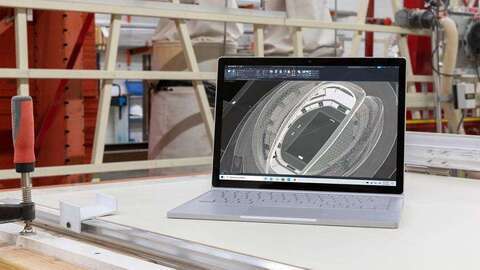Microsoft Surface Book Microsoft Surface Book 3 review: The ultimate 2-in-1 laptop
When I bought the Surface Book 2 in 2017, I made a mistake: I chose the version with 256GB of storage rather than 512GB. As I use this machine as my main device for all things work-related – and that includes an awful lot of high-resolution photos – I’ve been fighting an ongoing battle against storage space ever since. Needless to say, my credit card started twitching as soon as I heard news of the Surface Book 3.

Not that Microsoft has changed much with the Surface Book formula. Its key attraction remains a screen that detaches from the keyboard to become a tablet, and while this sounds similar to the Surface Pro series, in reality that product is a tablet first and a laptop second: the Surface Book spends the vast majority of its life as a fully functioning laptop, with its tablet persona only coming out to play when you need a slate.


Microsoft Surface Book 3 review: What you need to know
Physically, there’s no discernible difference between the Surface Book 2 and the Surface Book 3 (although you do get Wi-Fi 6 now). That means no extra USB-C ports, so you’re still stuck with one lonely USB-C connector on the right-hand side, with two USB-A slots and an SD card slot on the left. The only other port is for the Surface Connect, which you can use to charge the Book or connect the optional Surface Dock 2 (£260).
Those ports remain the same whichever size of the Surface Book 3 you choose. As before, we have the 13.5in version on test here, but you can go large with the Surface Book 3 15in. Aside from the increase in screen size, this also promises faster graphics thanks to a 6GB GeForce GTX 1660 Ti card – or even Quadro RTX 3000 graphics if you choose one of the “business” specifications.
The 13.5in Surface Book 3 includes the more humble GeForce GTX 1650 with 4GB of memory. And note that this chip is only provided with the Core i7 specifications: if you choose the cheaper Core i5-1035G7 version, you’re stuck with Intel’s integrated Iris Plus graphics.
The Nvidia card is tucked away in the base rather than the screen section with the rest of the computer’s internals, which means that even if you buy the Core i7 version it will slip back to Iris Plus acceleration when disconnected. This has never been a problem for me with the Surface Book 2, but your circumstances might vary.
Aside from the storage space issues on my Surface Book 2, the other big limitation was 8GB of RAM. If you buy the weakest version of the Surface Book 3, a Core i5 with integrated graphics, 8GB of memory and 256GB of storage, you’re going to suffer exactly the same limitations. Hardly fatal, but a bugbear.
READ NEXT: The best tablets you can buy
Microsoft Surface Book 3 review: Pricing and models available
If you can afford the extra £400 – and yes, the price really does jump from £1,599 to £1,999 without passing Go – you double up the RAM, gain a Core i7 and enjoy GeForce graphics, but are stuck with that 256GB SSD. Which means that the first spec with a 512GB SSD costs £2,449, with the only compensation coming in 32GB of RAM. If you want 1TB of storage, you’ll need to pay £2,699 for the top-end consumer model.
It’s a similar story for the 15in Surface Book 3, but this range starts at £2,199 for a Core i7/16GB/256GB combo, with a 32GB/512GB variant for £2,699 and a 1TB model for £2,899. None of these are going to win gongs for value.
Microsoft Surface Book 3 review: Benchmark performance
Whichever version you buy, you’re going to see a speed hike over the previous Surface Book, but don’t expect miracles. As we frequently point out, a slender body with minimal cooling opportunities means that the processor won’t run at full pelt for long before red flags start appearing and they’re told to slow down. So it is here.
I tested the Core i7-1065G7 version, and in short bursts it’s very quick indeed: that’s well illustrated by this laptop’s performance in our photo-editing test, which took it 74 seconds compared to 98 seconds for the Core i7 Surface Book 2. Similarly, a 1,276 result in the single-core Geekbench 5 test beats any current AMD Ryzen mobile chip.
If you’re looking for a system to tear through 3D renders, though, you’re far better off with a “proper” laptop. To use a handy example, the humble Honor MagicBook 14 took 90 seconds to finish our photo- editing benchmark – significantly slower than the Surface Book – but then completed our multitasking test in 23 minutes. Compare that to 34 minutes for the Surface Book 3.
Microsoft would have shaved some time off if it had chosen a faster SSD. While sequential read speeds of 1,702MB/sec are excellent, those tailed off to 555MB/sec when writing. Probably not enough of a slowdown to make much difference in most real-world tasks, but a potential bottleneck nonetheless.
One of the advantages of including the discrete Nvidia graphics chip in the base of the unit is that you give it more room to keep cool, and that means it won’t throttle back during games. Note, though, that you’ll still suffer when playing games that are CPU-limited, and I saw this most obviously during testing with Dirt: Showdown. From cold, the Surface Book averaged 104.3fps at 1080p (with High settings), but this dropped to 78.1fps when it was still running hot after a benchmarking session.
Both of those rates are more than playable, and if you stick to lower resolutions and unchallenging detail settings then you should find the Surface Book 3 can tackle modern games. Where you will struggle is playing games at the panel’s native resolution of 3,000 x 2,000; it spluttered to an average of 34.7fps in Metro: Last Light (High quality) at this resolution, but managed 52.3fps at 1080p.
Note that its gaming skills inevitably drop even further if you switch to the tablet alone, as it then relies on Intel’s integrated graphics. It managed only 38.4fps at 1080p in Dirt: Showdown, while its score in the GFXBench Car Chase off-screen test dropped from 152fps to 53fps.
READ NEXT: Surface Go 2 review
Microsoft Surface Book 3 review: Display performance
Where you will thoroughly enjoy using the Surface Book 3 for after-hours entertainment is when watching films. Back in the days when cross-Atlantic flights were a thing, I spent many a happy hour watching films on my Surface Book 2 – this is another time where its detachable screen comes to the fore, as you can detach it, flip the base around 180° and then reattach it. The screen moves closer to you and won’t get banged by a reclining seat in front.
While I obviously haven’t had the opportunity to put this to the test for the Surface Book 3, the screen appears to be identical. A peak brightness of 368cd/m² is great for every environment except bright sunshine (and even then it’s usable), while its colour performance is exemplary: it covers 90.6% of the sRGB gamut with an average Delta E of 0.85. A 1,624:1 contrast ratio adds yet further to its punchy appeal.
My only caveat is that its Adobe RGB and DCI-P3 coverage aren’t so strong, at 62.3% and 64% respectively. While that rules it out for print designers, don’t be put off if you’re a Netflix addict as dark scenes still render superbly on this device.
Microsoft Surface Book 3 review: Other features
It appears that Microsoft has upgraded the speakers. Whereas listening to music on the Book 2 was a chore due to sounds crunching together, it’s much clearer on the Book 3. At the start of Fleetwood Mac’s Tusk, for example, the drums sound like drums rather than someone tapping on margarine tub lids.
Microsoft has made a similar tweak to the front-facing webcam, which is still a 5-megapixel unit but now produces discernible detail. Not to give you nightmares, but my two-day-old stubble was clearly visible on the Book 3 whereas it looks more like grey fuzz on the Book 2. All of this means that if you’re looking for a laptop for video calls, the Surface Book 3 does the job admirably.
As with the Surface Book 2, the Surface Book 3’s tablet skills rely more on Windows 10 than the hardware. While the May update has made a couple of small improvements to the tablet “experience”, there’s still a cavernous distance between using an iPad Pro and a Windows tablet. It’s fine once you’re in your application of choice – and there are benefits to having desktop versions of apps rather than trimmed-down versions tailored for iOS – but navigation and switching between apps remains as big a pain as ever.
Viewed purely as a piece of hardware, however, there’s much to like about a detailed 13.5in screen that weighs 719g. You’ll need to invest an extra £100 in a Surface Pen, but it’s a pairing that generally works extremely well. I slip the word “generally” in there because the Pen relies on tips, and over time these wear down. A replacement pack of three tips costs a reasonable £20 from Microsoft’s store, but it’s one more thing to get annoyed about.
Also note that the tablet section contains a 18Wh battery, and that means you can only expect two hours of use. In our video rundown test, for instance, the tablet alone lasted for 1hr 30mins whereas it kept going for 9hrs 55mins when connected to the keyboard. What I will say, though, is that battery life degradation hasn’t proved to be an issue with my Surface Book 2: its 18Wh tablet battery now has a 16.5Wh battery capacity, while the main 57.3Wh battery in the base still has a 50Wh capacity.
The other big plus point is that you can charge via USB-C rather than carry around the supplied power supply, which is a hefty unit at 430g.
READ NEXT: The best laptops for students
Microsoft Surface Book 3 review: Verdict
Is the Surface Book 3 revolutionary? Has Microsoft made any notable improvements to things such as repairability, where the Book 2 earned a risible 1/10 rating from iFixit? That’s a big double “no”, with glue holding things together once you prise this machine’s back off. Nor does Microsoft’s single year of warranty impress, especially if you’re ordering for a business.
Then there’s the undeniable truth that the Surface Book format isn’t right for everyone. You can make many arguments for having a “proper” laptop accompanied by an iPad, or even for buying the Surface Pro instead – especially if the device is destined to be attached to a monitor on your desk most of the time.
More reasons not to buy? Compared to a 13in ultraportable, the Surface Book 3 is heavy at 1.64kg. Some people don’t like the way the screen and keyboard meet when closed, leaving a gap for dust and debris when in your bag, although I’ve never found that an issue in practice.
For some people, and I’d argue that they’re the vast majority, the Surface Book form factor doesn’t make sense. Only you will know if this 2-in-1 design – and unlike other so-called 2-in-1 devices, it truly is two machines in one package – meets your needs in such a way that you’re willing to sacrifice other areas. For me, it does. Which is why my Surface Book 2 is now heading for retirement, along with its annoying “you need to delete some files” messages.